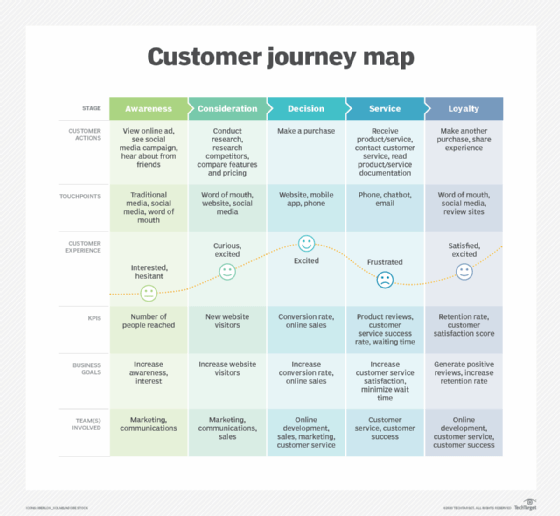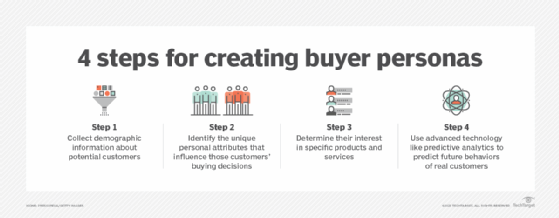What are buyer personas?
A buyer persona is a composite representation of a specific type of customer in a market segment. A market segment represents a collection of customers who share a common need. A buyer persona digs deeper into a subset of potential customers who have shared traits, such as similar demographic data or reasons for purchasing a certain product.
Buyer personas make clear who would need a certain product or service, what they need it for and why. They help organizations better understand their customers and prepare for future customer engagement with their brand.
When building customer personas, businesses should include information on any trait that might influence the potential customer's purchasing decision, such as age, gender and income. Personas also can include details about the customer's profession, whether they make purchasing decisions as part of their job and what they consider reliable sources of information when learning about new products.
For example, a business selling manufacturing raw materials would want its buyer personas to distinguish between certain customer job titles. For example, it would want to know if a person is a design engineer, who makes buying recommendations but not decisions, as opposed to a procurement officer, who does make buying decisions.
Why are buyer personas important?
Organizations create buyer personas to build an approximation of what an ideal customer or various ideal customers look like. These customer profiles help companies direct their marketing strategy toward attracting prospective customers that exist in the real world.
Most companies must create several personas to describe their target audience. Each persona is crafted to address a piece of the overall target market. For example, one persona might represent customers who prefer to shop online. Another persona would describe target customers who prefer to shop in a physical store. Other personas focus on various shared characteristics or pain points that draw a group of customers to the products or services being sold. Having a better understanding of buyer personas increases the likelihood of a positive customer experience (CX).
Buyer personas help product development, marketing campaign management and customer support teams execute product development, digital marketing and other marketing efforts as well as support initiatives. Personas ensure these efforts adhere to customer expectations, meet specific audience needs and resonate with real people as opposed to fictitious, ideal buyers.
Buyer personas are also an important tool for building customer journey maps, which guide a marketing team on how and when to deliver marketing messages to a specific segment of its customer base. As a company uses its marketing personas to create customer or buyer journey maps, it should consider more in-depth attributes, such as shopping habits for related goods and services, as well as payment and delivery preferences.

How to create a buyer persona
Businesses typically build large collections of customer personas, creating one individual persona at a time. The process is expedited with the use of a buyer persona template. There are four parts to this creation process. Three of the parts entail gathering essential information to be included in each persona, while the fourth is a guideline for analysis of large numbers of personas.
Demographic information
Buyer personas are created mathematically, using data gained from market segment analysis and recent customer behavior. The first step in creating one is collecting customer demographics information, such as age, sex, occupation, education level, marital status, geographic location and income.
Unique personal attributes
The next step is to identify information that sets a persona apart from others. This includes information such as the following:
- Whether these customers are final decision-makers.
- How they research products and services.
- What they consider sources of truth, such as advertisements or word-of-mouth recommendations.
- How they prefer to communicate.
- When and how they make decisions.
Interest in product or service
The third step is to look at reasons why this persona might be interested in the products or services a business offers. This can include the following:
- What motivates this type of buyer to buy the product or service?
- What needs of the customer does the product or service meet?
- What pain points does the product or service alleviate?
Artificial intelligence analysis
The final step entails using machine learning algorithms to analyze their data, glean insights and identify patterns that can help predict future behaviors of real customers.

How to do buyer persona research
Conducting buyer persona research involves a systematic approach to gathering insights about ideal customers. This research process combines various methods to create a comprehensive understanding of the target audience and various audience segments:
- Define research goals. The first step is to establish clear objectives for the research. This involves creating new personas, updating existing ones and exploring new market segments.
- Use existing data. Information already available within the organization can be useful. This might require analyzing data from customer relationship management systems, website analytics and feedback from customer-facing employees to determine customer needs.
- Conduct interviews and surveys. It's important to identify a diverse group of current customers that isn't limited to top buyers or recent acquisitions but represents a range of different types of customers. The conversations should be in-person when possible to get detailed insights. When direct conversations are not feasible, customer surveys can be an effective alternative.
- Analyze competitor success. Studying competitors' strategies can help to identify potential market segments and understand how they appeal to specific buyer personas.
- Use social media tools. Social media platforms offer valuable information about customer preferences and behaviors. They should incorporate this sort of analytics and metrics into the research process.
- Compile and organize data. Data management tools can streamline the process of compiling research data into a cohesive document.
- Continuously revise personas. As customer segments evolve, businesses must update buyer personas to maintain their accuracy and relevance.
Different types of buyer personas
Buyer personas can be categorized into various types, each reflecting distinct characteristics and behaviors of potential customers. These classifications help businesses tailor their marketing strategies and product offerings more effectively. The most common types of personas include the following:
- User persona. A user persona represents all potential users of a product or service. This type of persona is broad enough to encompass a range of users but also focused to provide valuable insights. It can help organizations understand who uses their product, even across multiple versions or tiers.
- Customer persona. For established businesses, a customer persona is based on existing customers. This type of persona provides valuable insights derived from real data about current buyers. It enables more accurate targeting and personalization, and helps with customer retention and conversion rates.
- Proto persona. This persona is useful for businesses that haven't launched yet but have an idea of their target customer. It represents an ideal customer while still maintaining a realistic perspective.
- Audience persona. Taking a broader view, an audience persona groups people based on shared interests and pain points. This approach is useful when targeting a wider demographic or when specific individual characteristics are less critical.
Benefits of buyer personas
Buyer personas offer organizations several benefits:
- Customer segmentation. One of the primary benefits of buyer personas is enhanced targeting and segmentation. Businesses can tailor their marketing efforts more effectively when they have a deep understanding of customer characteristics, preferences and behaviors.
- Customer retention. Companies can foster customer and brand loyalty and encourage repeat business when they understand each persona's expectations and challenges.
- Customer experience. Organizations can create a seamless and personalized journey through the buying process by aligning products, services and communication styles with customer preferences. CX is one of the most important factors in sales.
Examples of buyer personas
What follows are two buyer persona examples created based on market research done by two different types of businesses. The first is a retail setting involving a fitness center trying to expand its customer base by targeting new mothers wanting to get back into shape. The second is a business-to-business setting, where a data security company is targeting IT departments looking to secure their organization's data.
Example 1: Fitness center targeting new mothers
Key demographics
- Female.
- 20 to 40 years old.
- Stays at home full time or has a full-time career with maternity leave.
- Has sufficient income to spend on monthly fitness center and personal trainer fees.
Unique identifiers
- Looks to social media and online reviews for product and service recommendations.
- Wants a fitness center within 10 minutes driving distance of her home.
- Requires date and time flexibility in her workout routine.
- On-site childcare is a plus.
Purchase characteristics
- Wants to start soon.
- Is willing to pay extra for specialized training that's unique to her situation.
- Requires staff that can help keep her motivated.
- Has specific weight loss and fitness goals in mind.
Example 2: Data security company targeting corporate IT departments
Key demographics
- IT management job title.
- 30 to 65 years old.
- College-educated.
- Earns $60,000 to $160,000, annually.
Unique identifiers
- Is the final decision-maker on IT-related purchases.
- Uses technical resources in-house to help make purchase decisions.
- Reviews industry analyses from trusted tech-focused resources.
- Prefers face-to-face meetings with IT product and service vendors.
Purchase characteristics
- Responding to upper management growing concern with business data leaks.
- Wants to consider multiple options before making a purchase decision.
- Tends to purchase products and services from partners the company already works with and trusts.
- Looking for a product that fits the department's overall technical roadmap.
Businesses can develop personalization strategies for their content marketing that let their marketing and sales teams provide relevant content to customers when they need it. Learn how CX personalization works.






